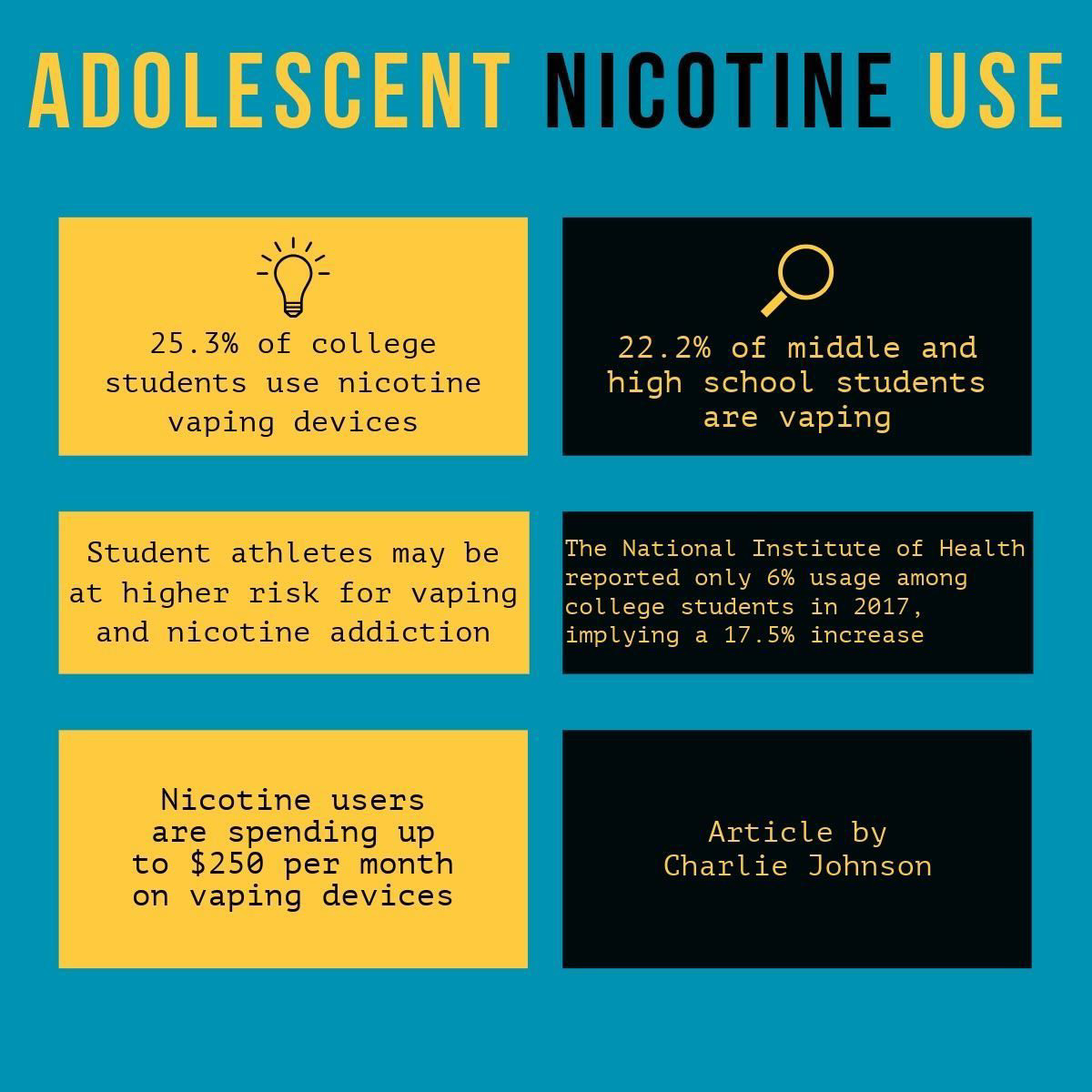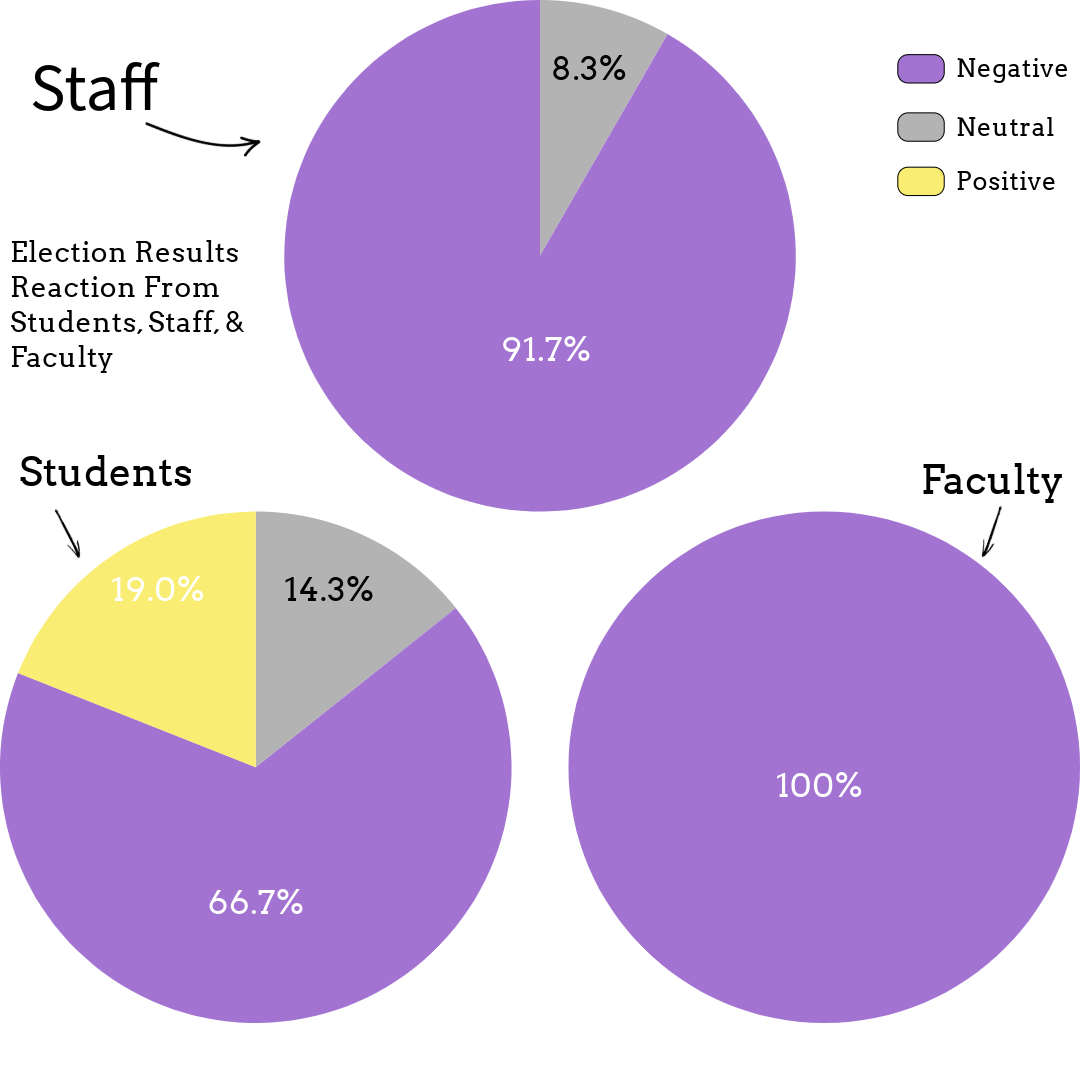According to survey data from Statista, recurring and daily electronic cigarette usage has reached 23.5% among college students as of 2023. The National Institute of Health reported only 6% usage among college students in 2017, implying a 17.5% increase, despite e-cigarettes existing since 2003. The Centers for Disease Control and Prevention stated that 22.2% of middle and high school students used tobacco products as of 2023, with e-cigarettes being the most common device.
“It’s a big issue, it’s a scary issue. And it’s one that we should be addressing much, much earlier in the educational system than college,” Exercise Science Professor Louise Kelly said. “By college, there’s a lot of damage already done.”
First-year student Jordan Isaiah said that vaping has become commonplace in social settings, especially in young adults.
“Vaping has become a norm, to be honest. It’s happening in middle schools as well,” Isaiah said. “My sister’s younger friends are already doing that, they’re like twelve and thirteen. I think it’s the marketing, the flavors, and all that, but it’s also just kids. It’s peer pressure.”
Kelly said the rise of vaping could be attributed to the social media marketing and flavor profiles made available through these products, causing younger demographics to get addicted. Kelly also said that the effects of these devices are far from harmless, despite many misleading advertisements regarding vaping as a safe alternative to cigarettes.
“Initially, we do animal studies,” Kelly said. “They’re causing severe lung damage, severe cardiovascular damage. Then when we see the translation into some human studies, we’re seeing the exact same thing. It’s causing severe lung damage, severe cardiovascular damage, inflammation, and an increase in oxidative stress which is cancer-producing.”
The American Academy of Pediatrics reported that teenage student-athletes are also at a higher risk of nicotine addiction, stating that they often pursue e-cigarettes over smoking as an attempt to access nicotine in a healthier fashion. Kelly said this poses an extremely high risk to their performance capabilities.
“It’s going to have a significant decrease in athletic performance, absolutely. They’re going to try and train harder, right? ‘I’m not performing the way I was, I’m going to train harder,’” Kelly said. “They’re going to smoke more because now they’re more stressed, so it’s going to be that vicious cycle.”
Kelly said that the stresses of college can make nicotine usage seem appealing for any students, especially if they were predisposed in adolescence. However, Psychologist and Director of Counseling and Psychological Services Anna Guerin said that using nicotine as a coping mechanism may even go as far as creating an inverse effect on stress management for students.
“As a young adult, your brain is still developing, so long-term nicotine use can actually reduce your ability to manage some stressors,” Guerin said. “Nicotine increases your dopamine, which helps you perceive stress less. So a lot of people will use nicotine to manage stress, and then you get addicted, and then have to use it to function.”
Isaiah said he has experienced frustrations with the necessity that nicotine has become in his own life.
“You don’t wanna go through withdrawals,” Isaiah said. “I’m mad at everyone. I can’t keep a conversation without getting heated for no reason.”
Guerin said that people have misconceptions about how difficult it can be to quit nicotine.
“Some people will think, ‘Oh just don’t buy it, you’ll be fine.’ It can be very difficult. Some people have to try several times,” Guerin said. “Your brain is getting used to not having all that dopamine, all those hits. And also, psychologically, you have to figure out how to manage something that you’re used to doing, and that can trigger other thoughts and feelings. Some people will feel brain fog, super irritable, their appetite is going to go up.”
Guerin said that it usually takes around three days for the worst of the chemically induced withdrawals to subside, but that there will still be psychological and behavioral struggles following.
In an attempt to reduce youth accessibility to vaping and nicotine abuse, California passed a law in November 2022 prohibiting the sales of any flavored tobacco and nicotine products. However, Isaiah said he finds this ineffective, stating he has access to purchase them elsewhere in the state.
“It’s just gas stations because gas stations are more regulated and corporate. So if a corporate member comes in and sees flavored nicotine, you’re screwed. But liquor stores, other gas stations, they’re all in the back,” Isaiah said.
Kelly said a more effective approach could be utilizing more effective anti-nicotine public service announcements that are used in other countries.
“What’s different in other parts of the world is that they don’t shy away from the gore, they’ll show it very realistically,” Kelly said. “You have parents coming in, telling students what’s happened to their kids, or that their kids have passed away from what’s happened. I think that’s hard-hitting. So, to me, there’s gotta be a statewide campaign, from the top down, putting it into curriculums and health education.”
Guerin said that students who are trying to quit should set up a safety and cessation plan for themselves to ensure that triggers are reduced and they remain supported.
“For some people, it works to wake up one morning and think, ‘okay, I’m done.’ For the vast majority of people, they need to have a plan in place,” Guerin said. “For example, if you don’t want to eat ice cream anymore, you have to get all the ice cream out of your fridge. You also might have to think about who you are around, and really get their commitment too.”
Kelly said that students should also try and find support around themselves while trying to quit, such as friends or seeking out local support groups that handle the struggles of addiction.
“No matter what you’re going through, whether it’s withdrawal from nicotine or anything else, having someone going through it with you or has gone through it, is your best support,” Kelly said. “It’s easy for me to say ‘Hey, you need to stop because x, y, and z,’ but I’ve never done it. So I don’t understand the physiological and mental draw to it.”
Isaiah advised non-users to remain preventative from creating the habit for themselves by refusing to purchase their own vaping devices.
“Just don’t do it. Genuinely, there’s zero point at all,” Isaiah said. “It’s avoidable, so avoid it. It’s going to affect your lungs and your wallet.”
The NIH reported that electronic cigarette users spend an average of $50 to $75 a month on nicotine products. The study found that some users were spending upwards of $250 a month, totaling at a possible $3,000 per year.
Students who are struggling with addiction can contact Counseling and Psychological Services at 805-493-3727 for setting up therapeutic appointments, or use the TimelyCare app for 24-hour virtual support, free of charge.













